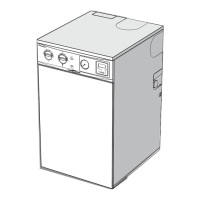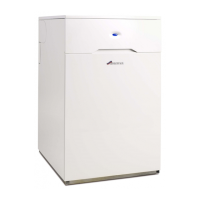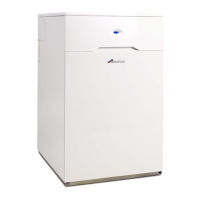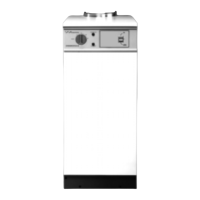29
Any extra vessel fitted must be pressurised to the same figure as
the integral vessel. If the expansion vessel fails then the specified
replacement must be fitted.
16.4 Check the Burner
1.
Check that the nozzle and electrode settings are correct for
the relevant burner. See Figs 23, 24, 25 and 26.
2. Check that the nozzle lies central with the combustion head hole.
3. Check for any visible defects.
16.5 Replace the burner.
1.
Connect the flexible oil supply hose to the isolating valve
bulkhead fitting and tighten sufficiently to form a good seal.
Where a double pipe system is being used fit the bypass plug,
as described in Fig. 12 and connect the oil return pipe fitting.
2. With the sponge O-ring gasket around the burner blast tube
insert the burner into the housing tube. Push the burner firmly
forward to compress the gasket and tighten the two locking
screws with a 5mm allen key.
NOTE: It is important that a good seal is made between the
burner and the boiler to prevent re-circulation of the flue gases
from the combustion chamber to the burner inlet, or the room in
the case of a CF/LLD appliance.
3. On the RS balanced flue model, feed the electrical lead back
through the hole in the burner surround housing and fit the
grommet into the hole ensuring a seal is made.
4. Re-connect the electrical lead plug into the control box.
16.6 Check the installation.
1.
Check that the appliance is correctly wired as described in
Section 13.
2. Check that all baffles are correctly located and the heatshield
(20/25 and 26/32 models only) is correctly mounted as shown
in Fig 27c.
3. Check that the baffle retainer is correctly mounted (20/25 an
26/32 modesl only) as shown in Fig 27c.
4. Check that the four thermostat phials are correctly located in
the thermostat pockets positioned in the top front of the boiler
and in the Heatslave tank.
5. Check that all of the air-ways to the burner are clear of any
obstruction.
16.7 Fit a pressure gauge and manifold to the burner pump at
the point indicated in Fig 12, or the pressure gauge port shown
in Fig 25 on the 20/25.
16.8 Turn on the electricity to the appliance.
16.9 Bleed the burner
Single pipe system
Release the fuel bleed port on the manifold and place a suitable
receptacle beneath. Turn on the Central Heating Control
Thermostat. Set the operating switch (or programmer) to
heating and hot water and allow the burner to run through to
Lockout. Wait two minutes and reset the burner control box.
Repeat the procedure at least three times or until a steady
stream of oil, without air, is exhausted from the bleed port. Re-
lock the bleed port.
Double Pipe System
A two pipe system will automatically vent the air back to the oil
tank. Turn on the Central Heating Control Thermostat. Set the
operating switch (or programmer) to heating and hot water and
allow the burner to run through to lockout. Wait two minutes
and reset the burner control box. Repeat the procedure until the
burner fires and runs in a steady state. This may take several
attempts depending on the oil pipe length and height.
Single pipe suction lift system with de-aerator
A single pipe suction lift system with de-aerator will automati-
cally vent air through the de-aerator by turning on the boiler
thermostat. Set the operating switch (or programmer) to heating
and hot water and allow the boiler to run to lockout. Wait two
minutes and reset the burner control box. Repeat the procedure
until the burner fires and runs in a steady state.
On long oil pipe runs from the oil tank to the boiler it is recom-
mended that the de-aerator be primed to prevent damage to the
oil pump.
To prime the the de-aerator follow the following procedure:
a) Disconnect the flexible oil inlet hose nearest to the de-
aerator and place the end in a container of oil.
b) Place an empty container to collect oil from the oil
inlet pipe connection of the de-aerator.
c) Prime the de-aerator and reconnect the de-aerator
to the flexible oil inlet hose.
16.10 Adjust the air shutter and pump pressure to the settings
recommended in the appropriate Table 2 to 6. After a pre-
ignition period of approximately 15 seconds the burner should
ignite. Flame sensing is carried out by means of a photocell
mounted in the burner body. Should the boiler fail to establish a
normal firing pattern (or should flame failure occur during
running) the absence of a flame is sensed and the control box is
monitored to a safe lockout condition and the burner is shut
down. The Lockout indicator light on the appliance facia panel
will illuminate indicating that the burner has gone to lockout. In
this instance wait two minutes, remove the appliance front
cover and press the red lockout reset button mounted on the
burner control box. Another start sequence is then initiated.
Repeat the procedure until a flame is established.
NOTE: Persistent Lockout when running indicates a fault and a
Service Engineer should be consulted.
16.11 Run the boiler for approximately three minutes and then
switch off checking that there is no after-spurting from the
nozzle. This can be detected by oil saturation on the blast tube.
If after-spurting occurs, remove the burner from the boiler,
unscrew the nozzle and while holding the burner in a vertical
position, fill the nozzle holder with oil. Refit the burner and
continue to run the boiler for three minute periods until after-
spurting stops.
NOTE: In order that after spurting is reduced to a minimum
during the commissioning period it is recommended that a
pressure gauge only is fitted on the external pressure gauge port
on the Electro Oil B11 (see Fig. 25). Use of a “T” piece pressure
gauge manifold will increase the oil line volume and hence
increase the degree of after-spurting.
16.12. Run the boiler for a further 15 minute period and then
finally fine tune the air shutter setting to give the CO
2
levels
specified in the appropriate Table 2 to 6 less 0.5% CO
2
. During
this period some smoke will be emitted due to the burning of
organic binder in the base insulation board. Smoke readings will
therefore be inaccurate at this point.
NOTE: A flue gas sampling point is located on the boiler top
plate.
16.13. Check that the smoke reading is in the range 0-1. If this
cannot be achieved check that the burner head is set correctly
and the nozzle is in good condition.
16.14. Check that the flue gas temperature does not exceed the
values specified in Tables 2 to 6. If the flue gas temperature is
too high, check that the baffles are correctly located. If the
baffles are correctly located then reduce the pump pressure
since nozzle variations of up to + or-15% may occur.
16.15 Turn off the electrical supply to the appliance and isolate
the oil supply to the burner. Remove the oil pressure gauge and
manifold and re-fit the blanking plug. Check the oil system for
any signs of leakage.
16.16 On the RS balanced flue model re-fit the burner box cover
by lining up the four ball studs, and the polarising pin in the top
flange of the box, and firmly pushing forward. Check that the
cover is properly seated by pressing forwards on the front top and
then bottom face of the box to ensure a room seal is achieved.
On the CF/LLD model fit the cabinet front panel.
16.17 Allow the burner to run for a further five minutes and
then recheck the CO
2
level and adjust the air setting if required.
With the burner cover/panel fitted as 16.16, repeat the previous
test procedure and check that the smoke is in the range 0-1.
Repeat the fine tuning procedure if found necessary.
16.18 Re-fit the blanking plug in the flue sampling hole.
16.19 Refit the cabinet top and front panels in reverse order to
that described in Section 5.
16.20 Operation
Turn on the electricity supply to the appliance
Domestic Hot Water Mode
Set the operating switch (or programmer) to off and fully open a
hot tap.

